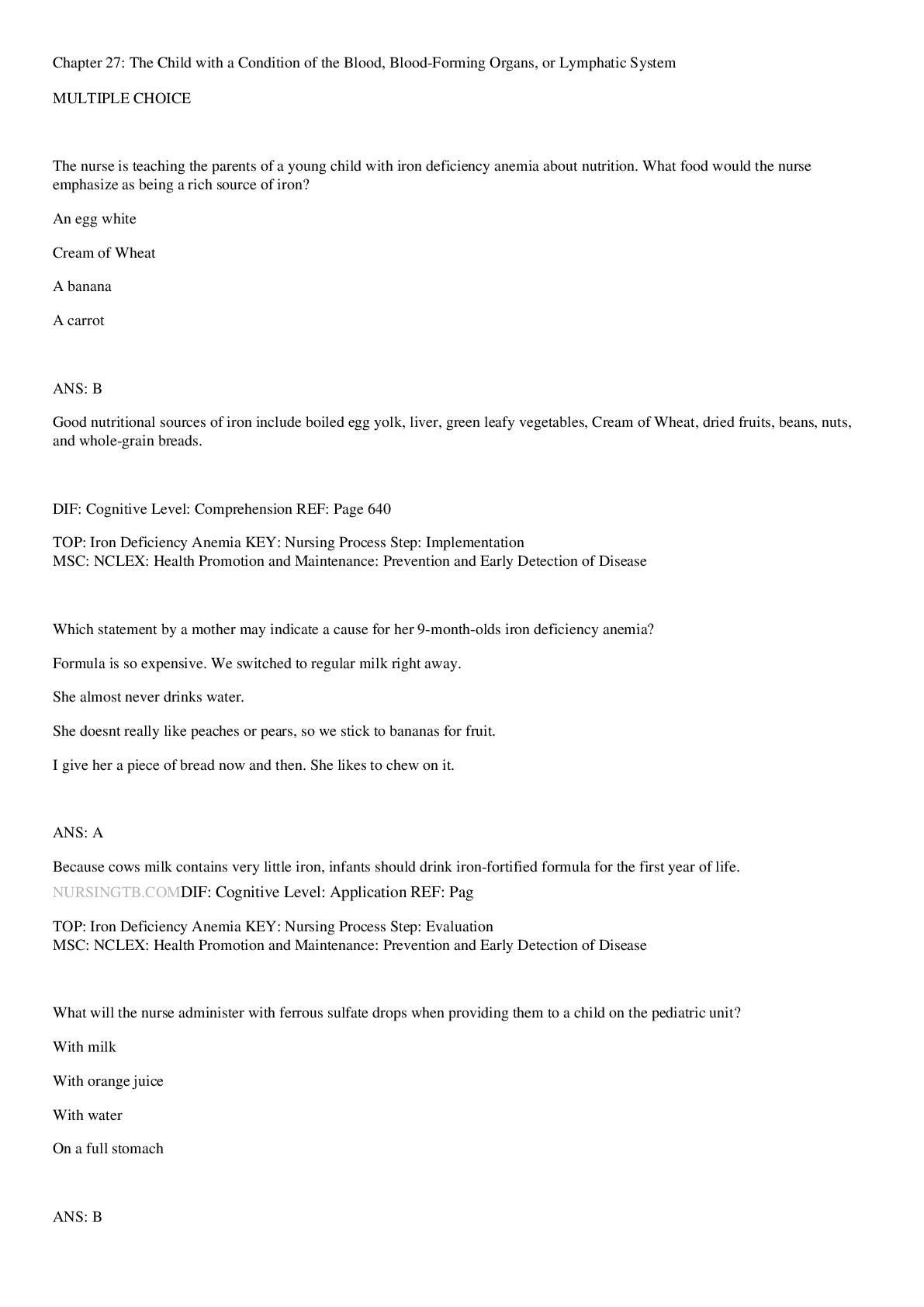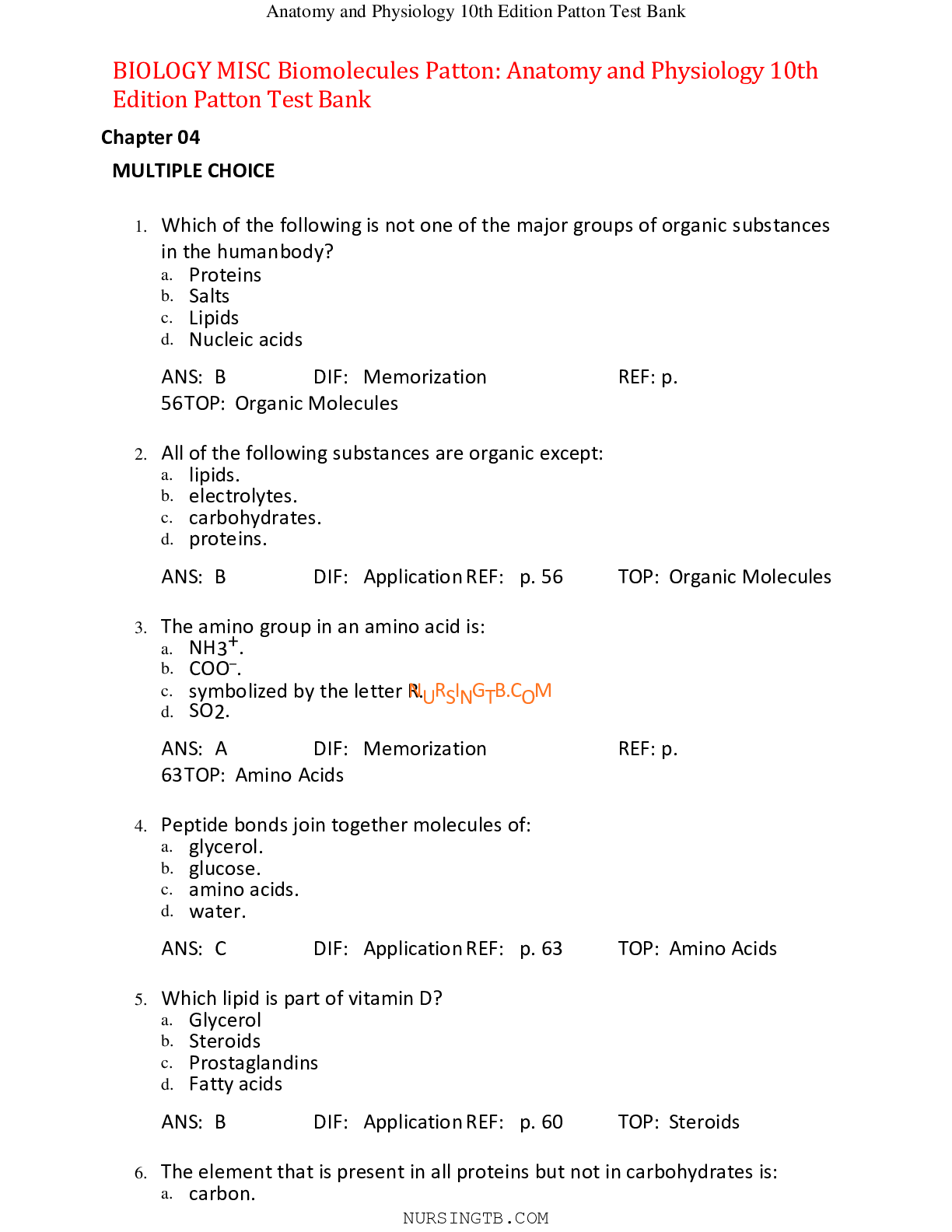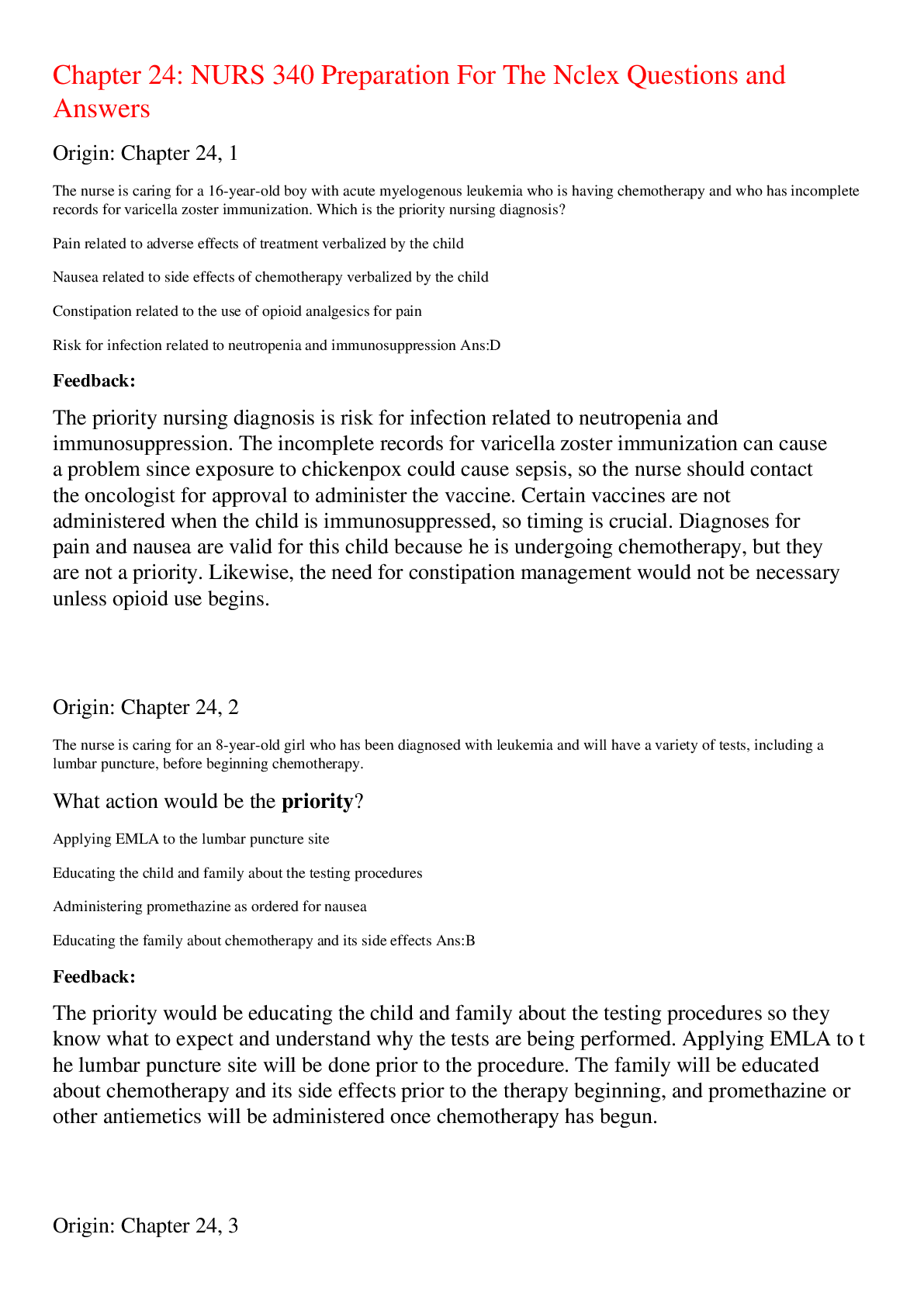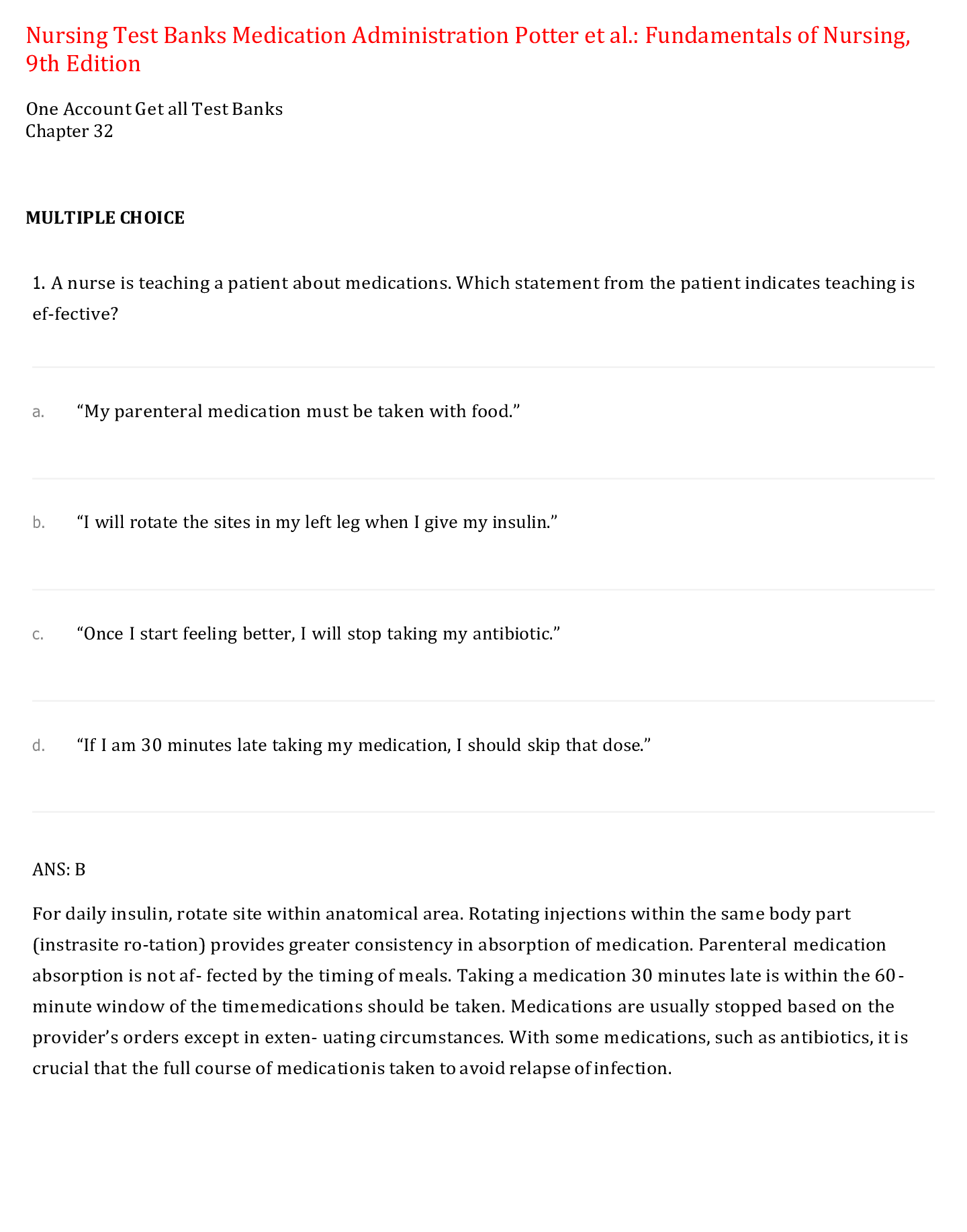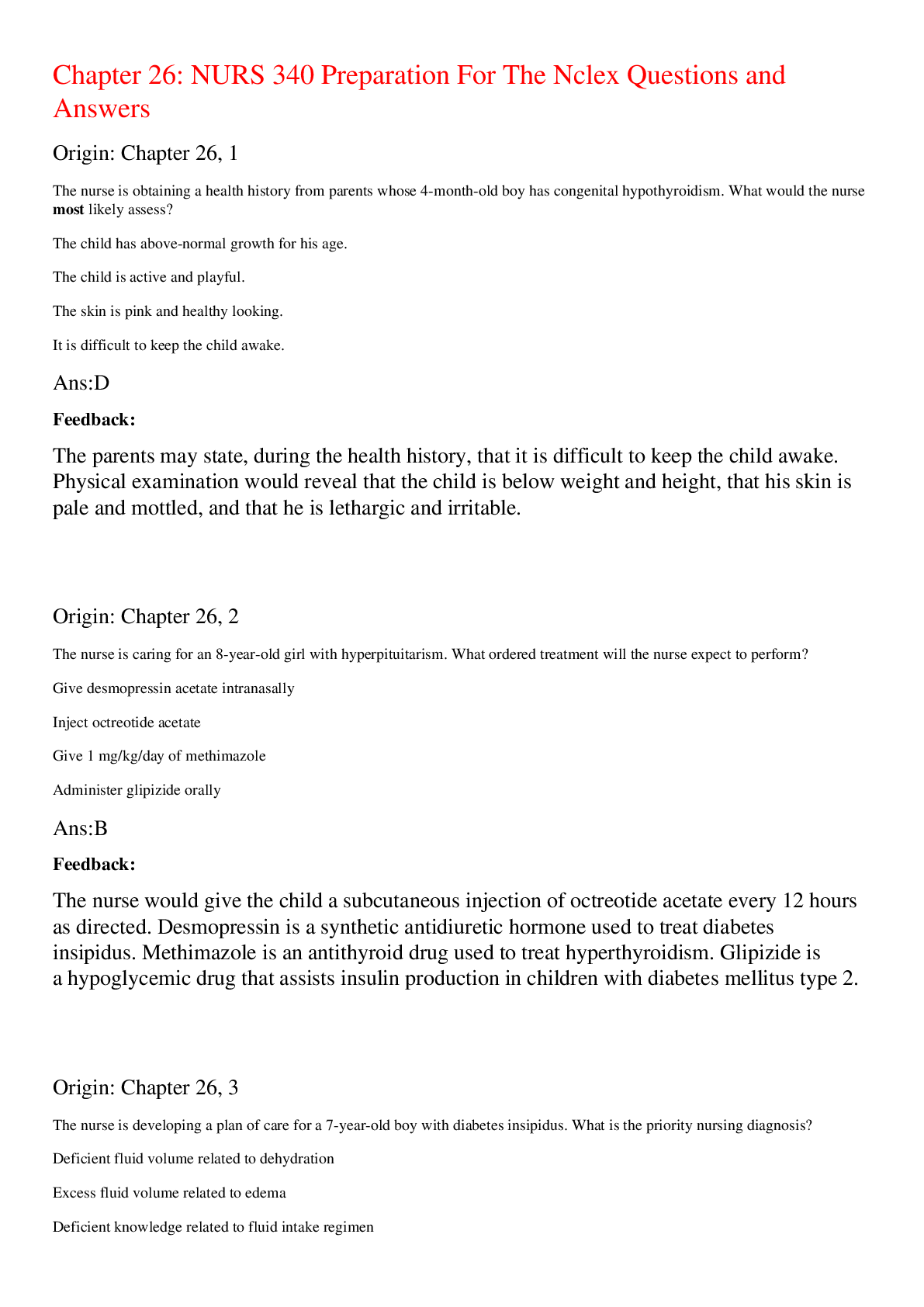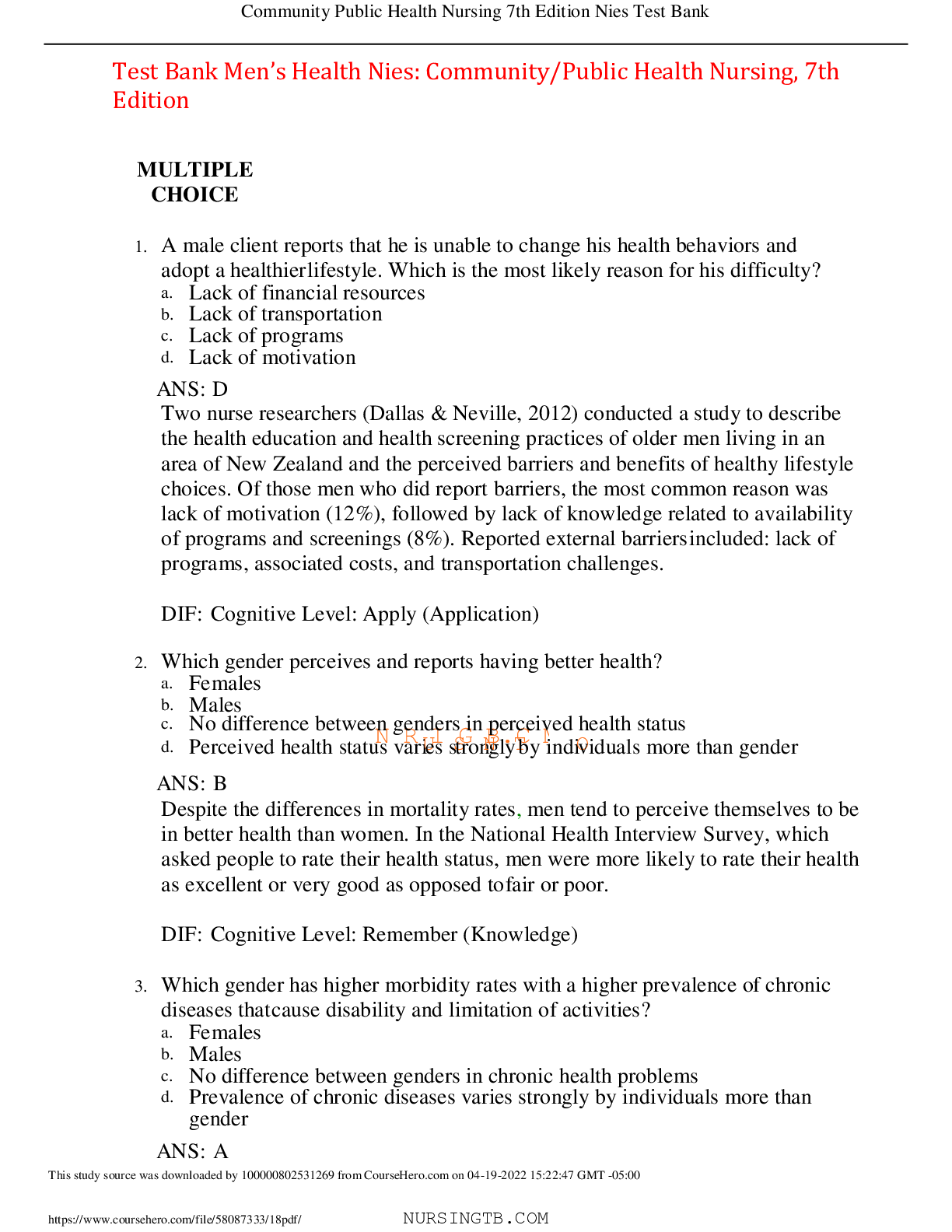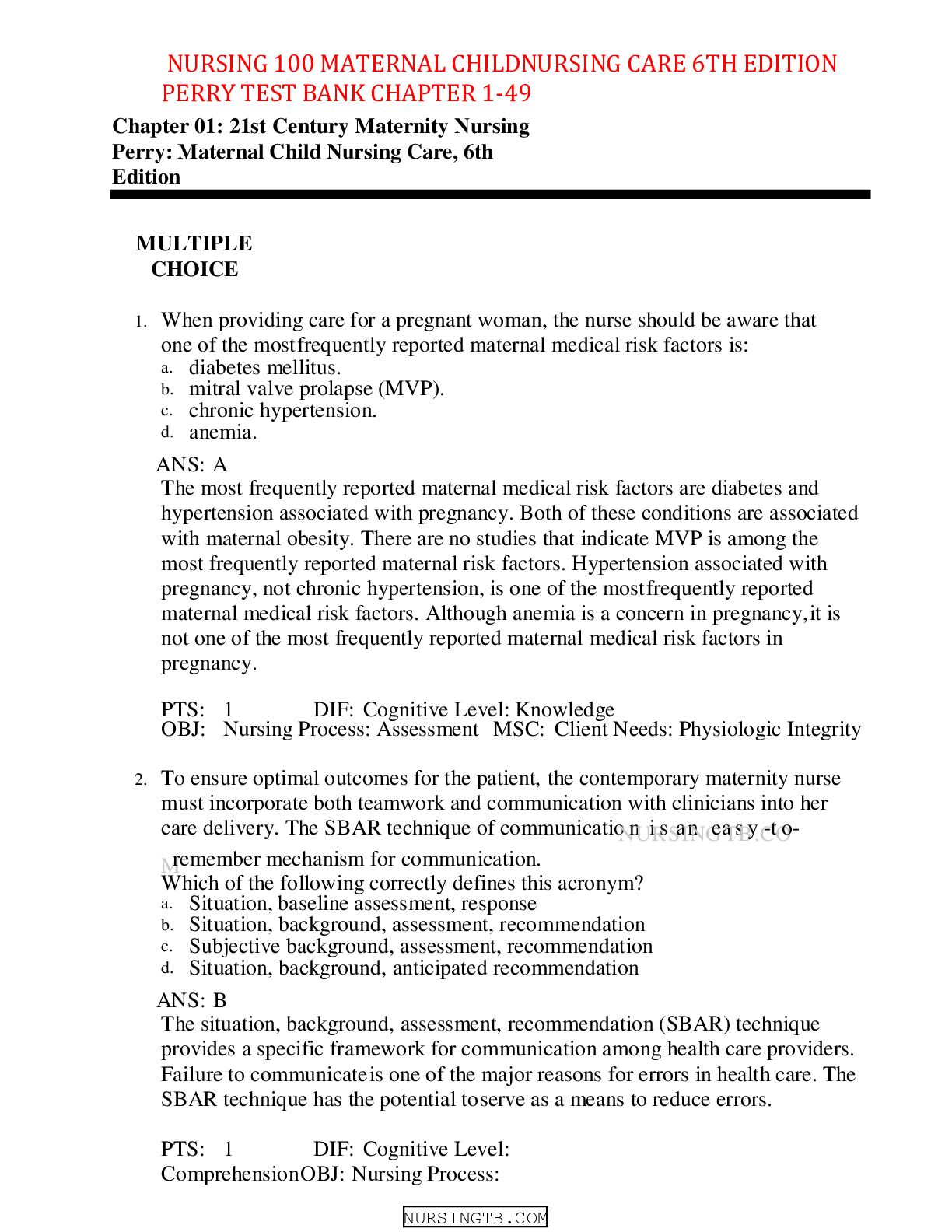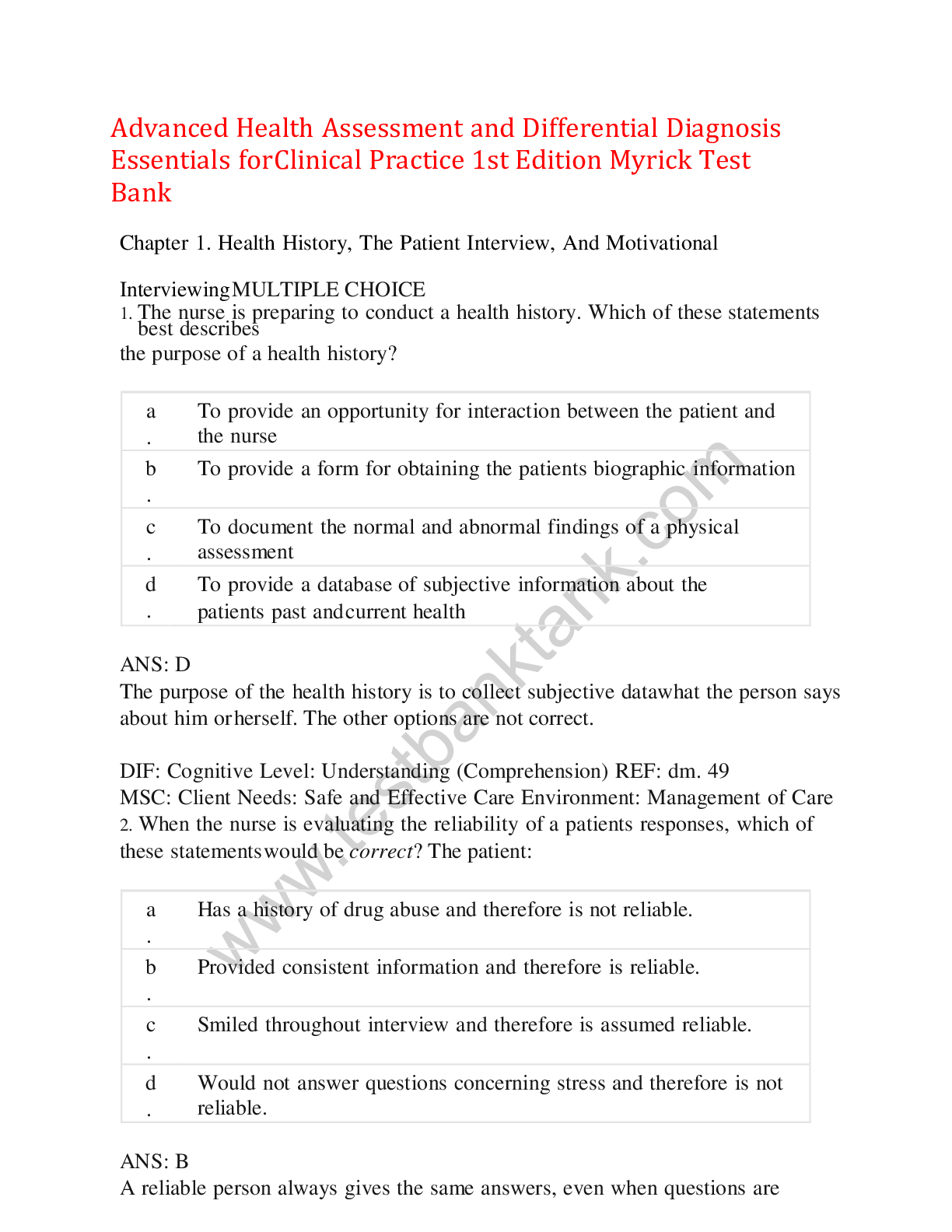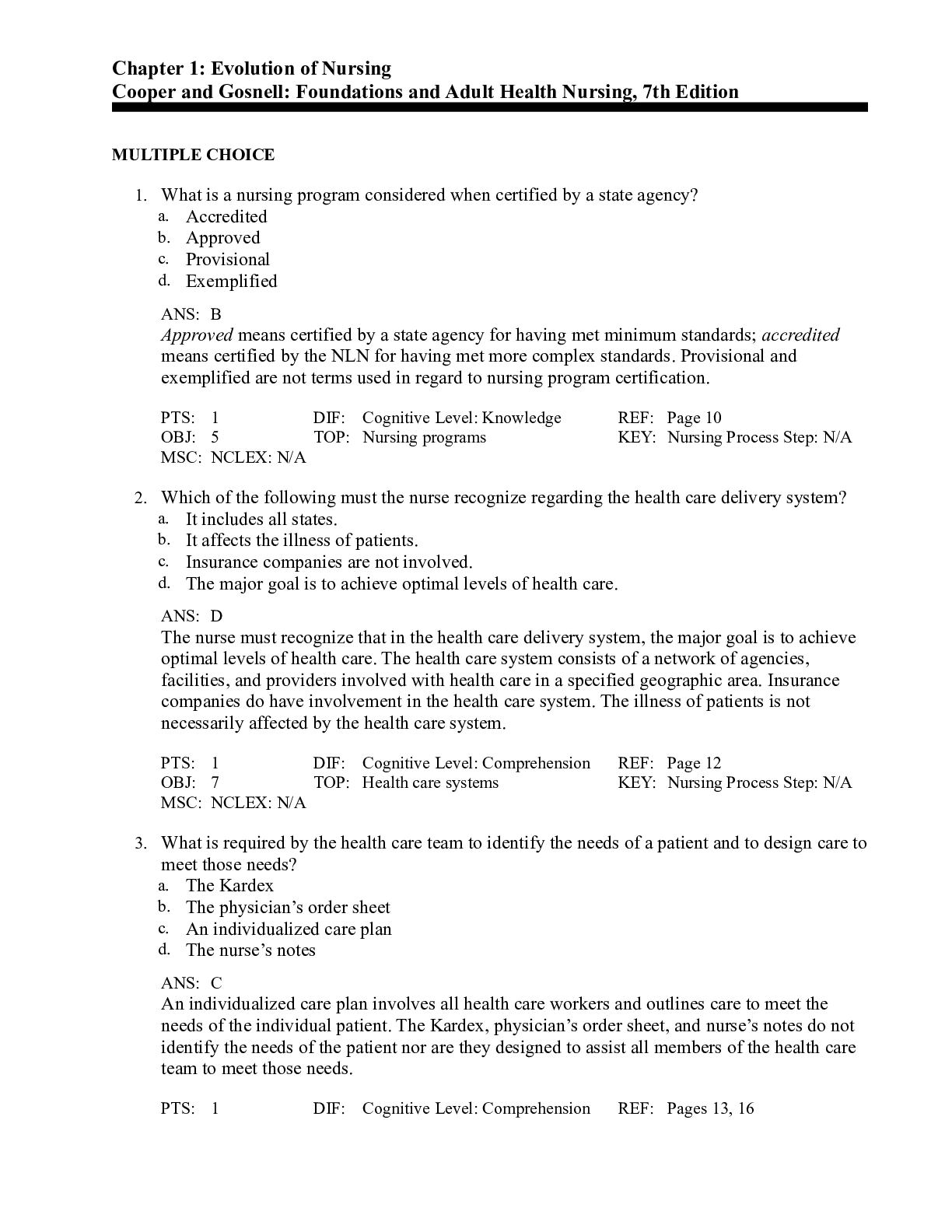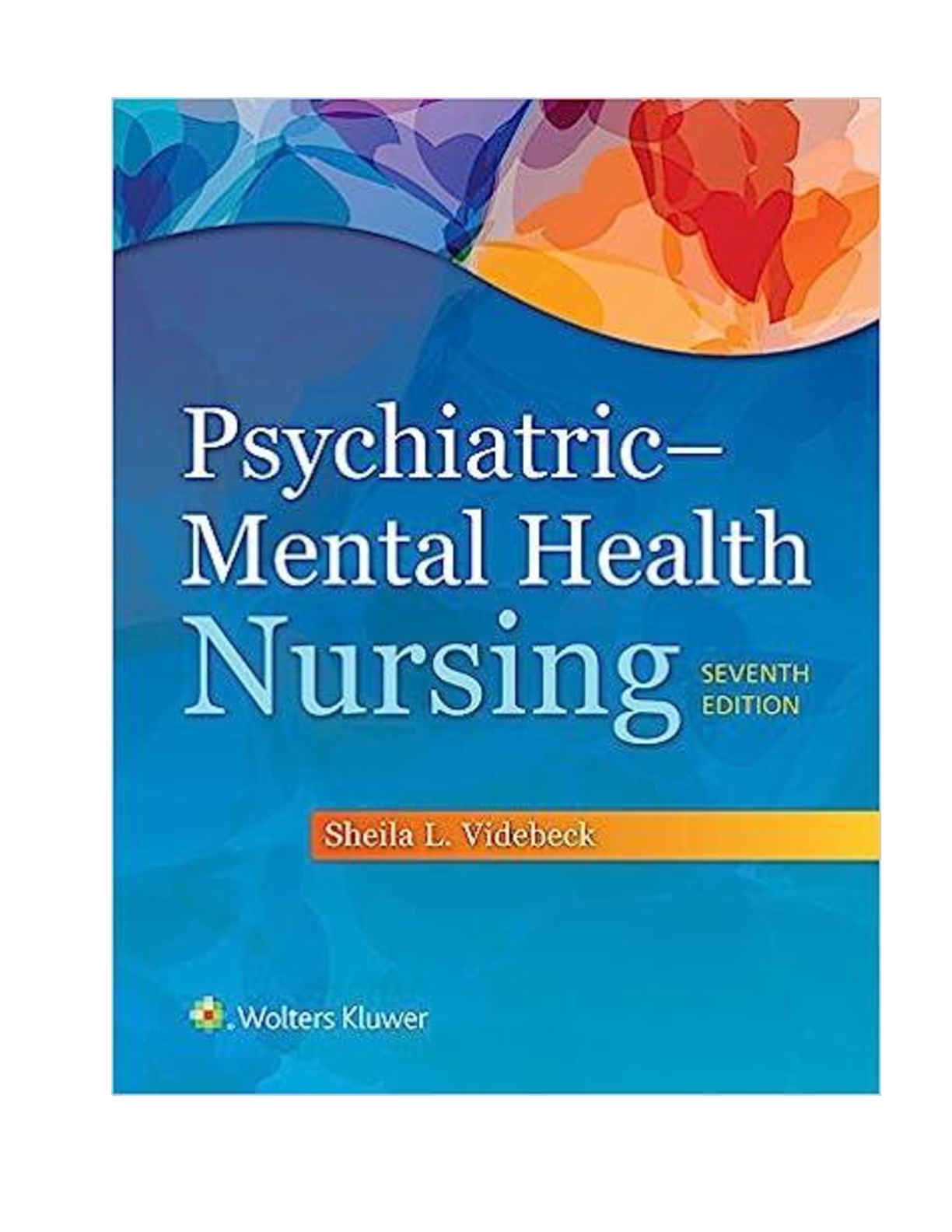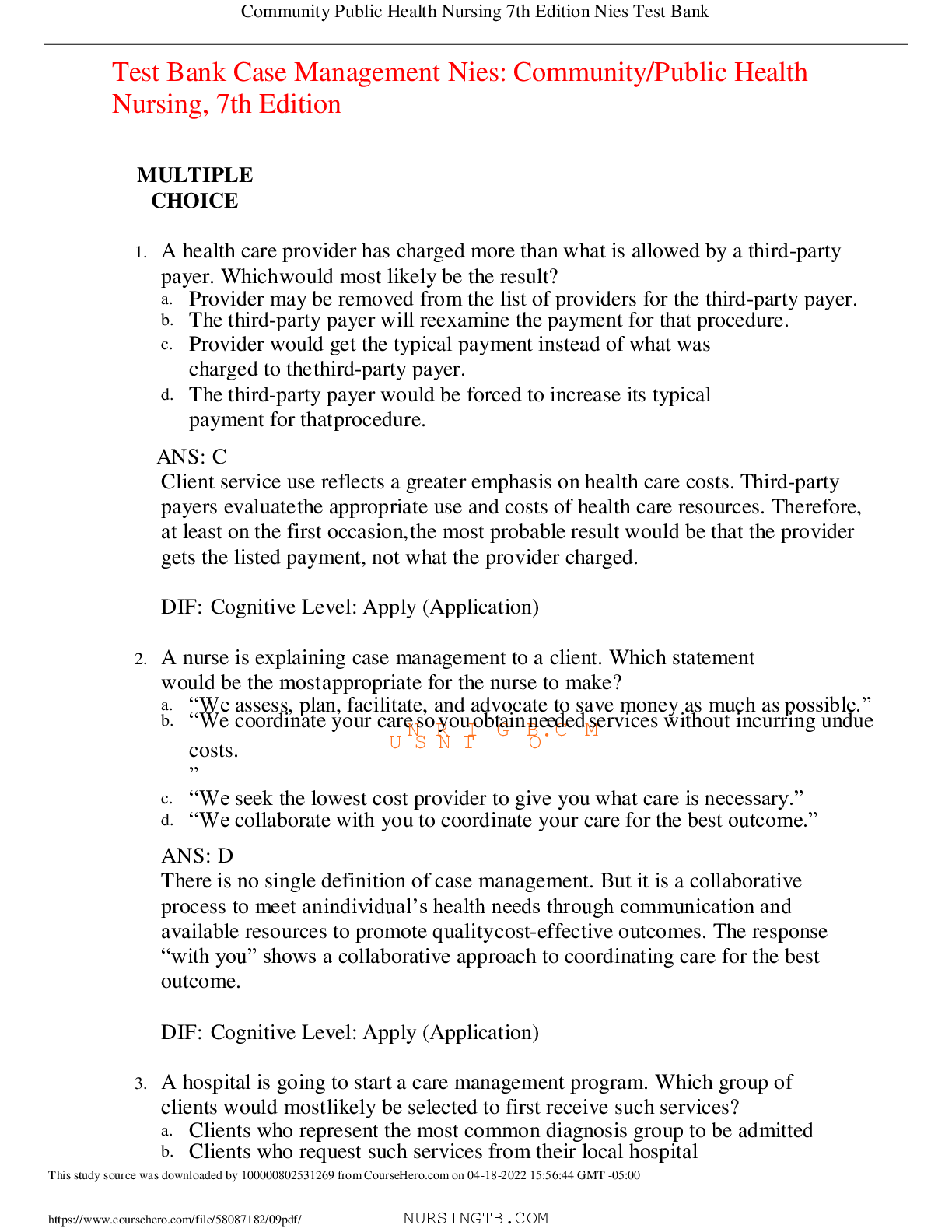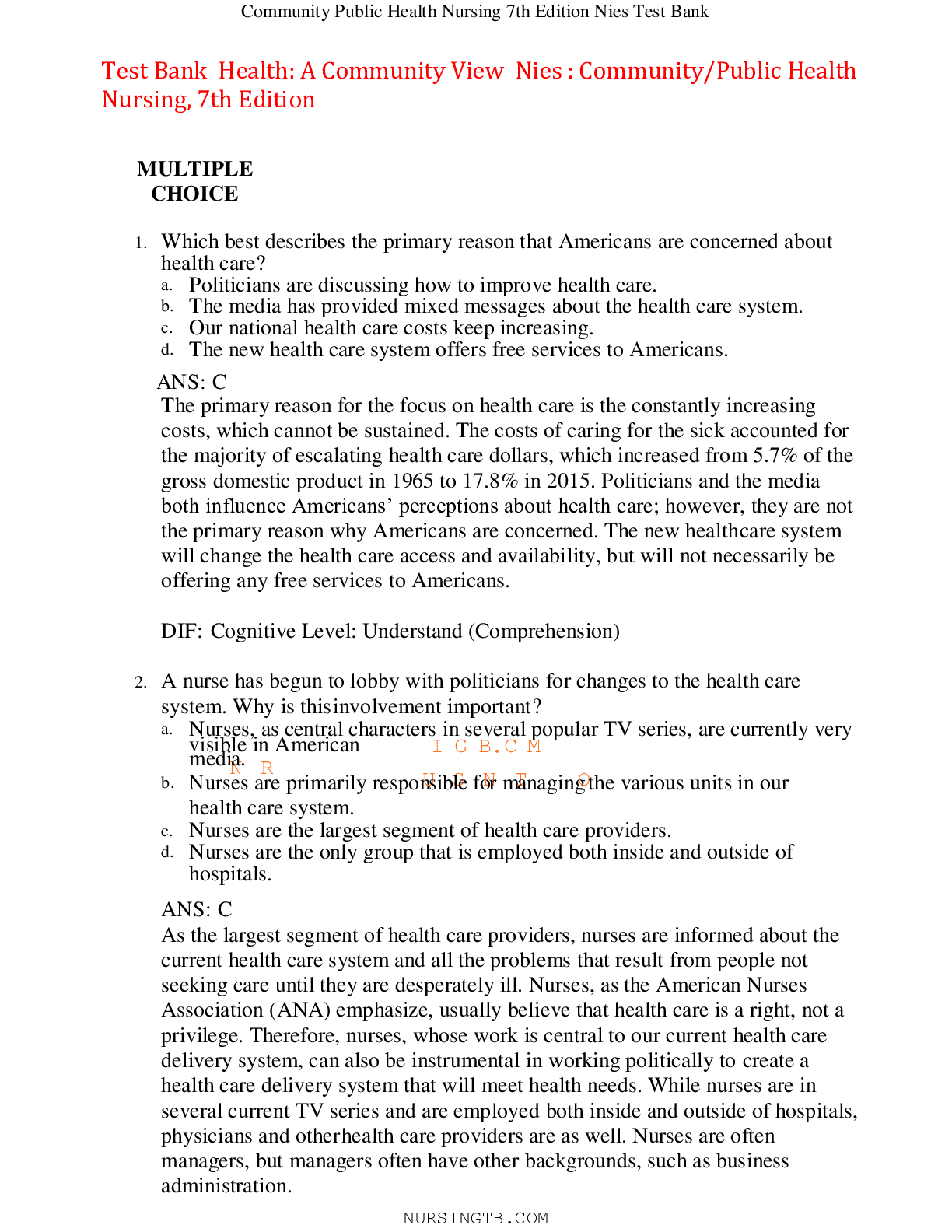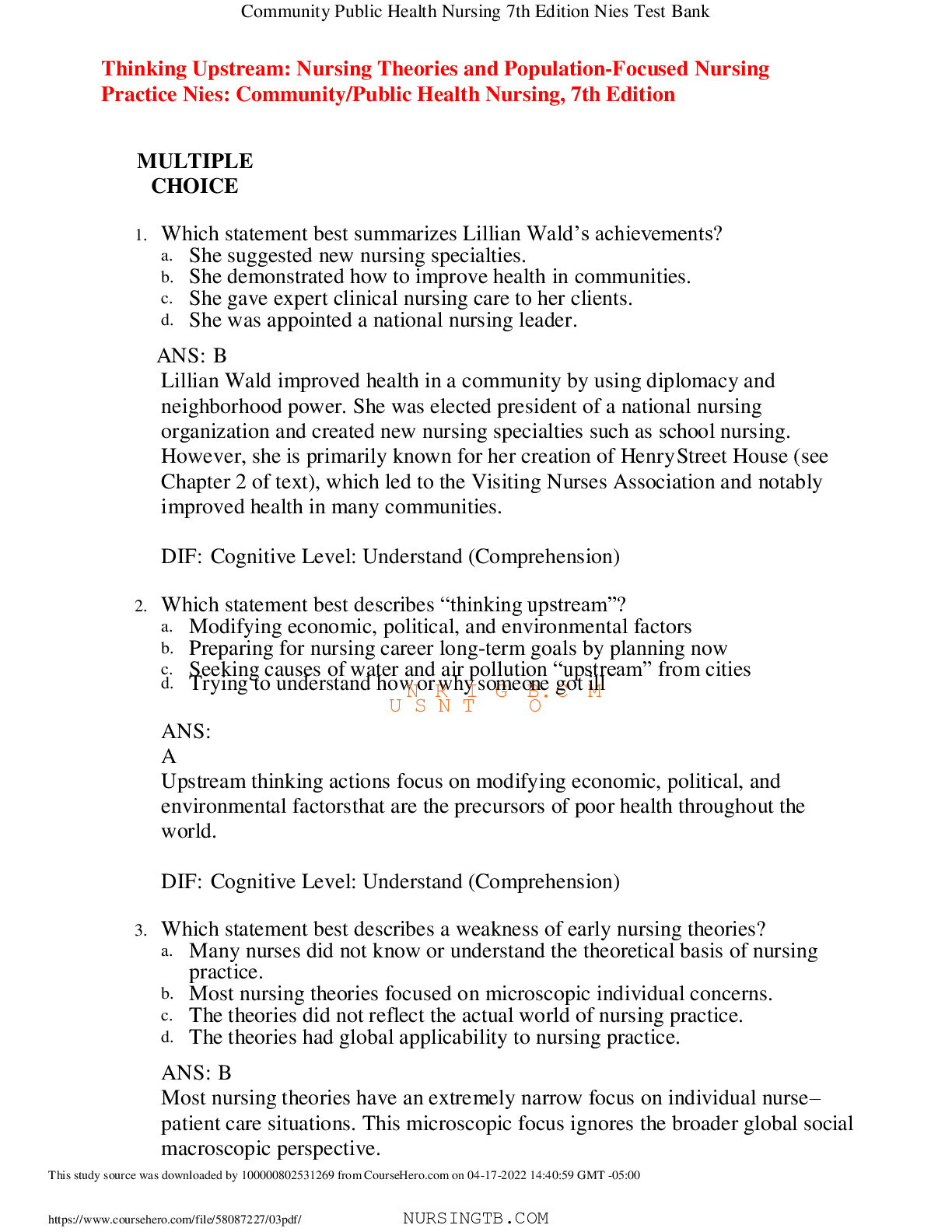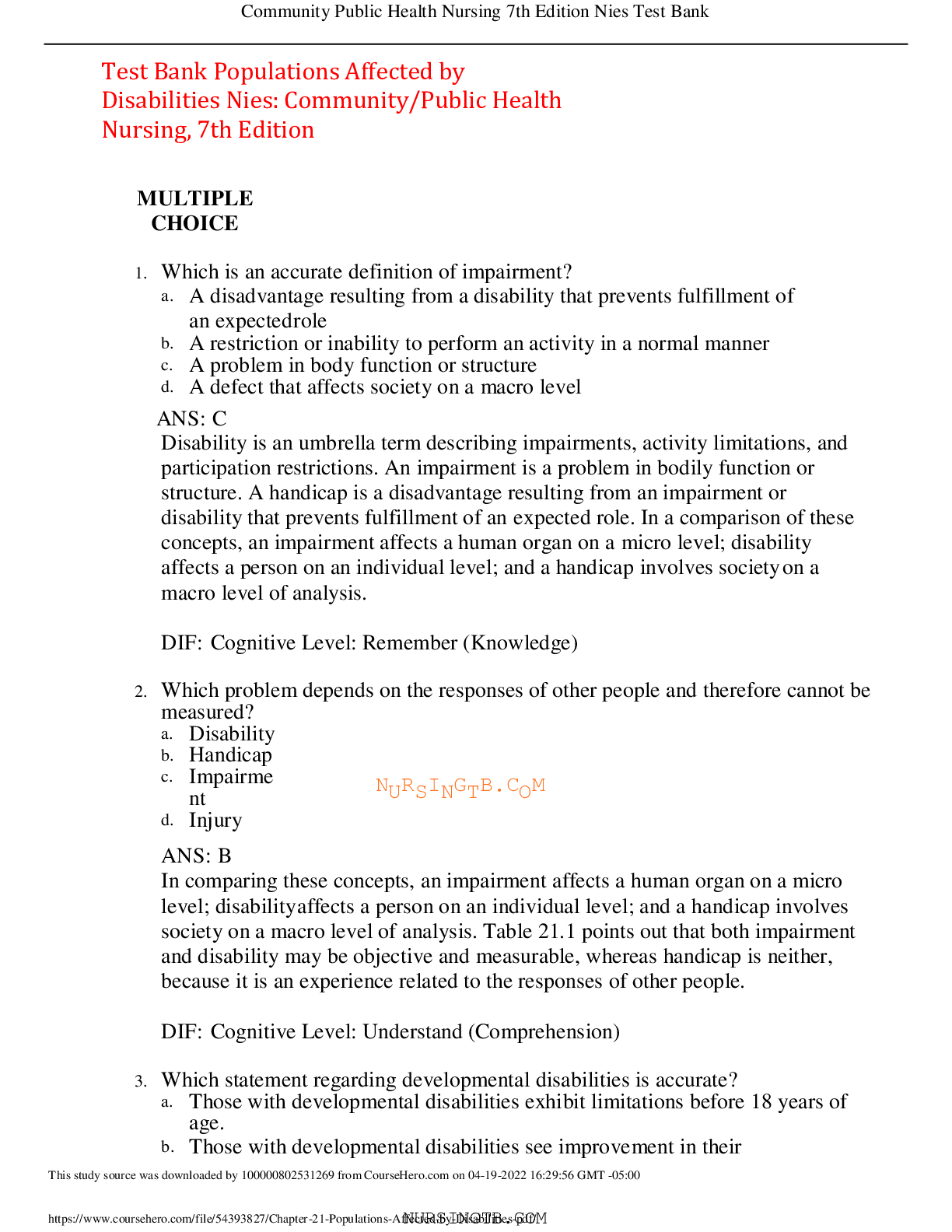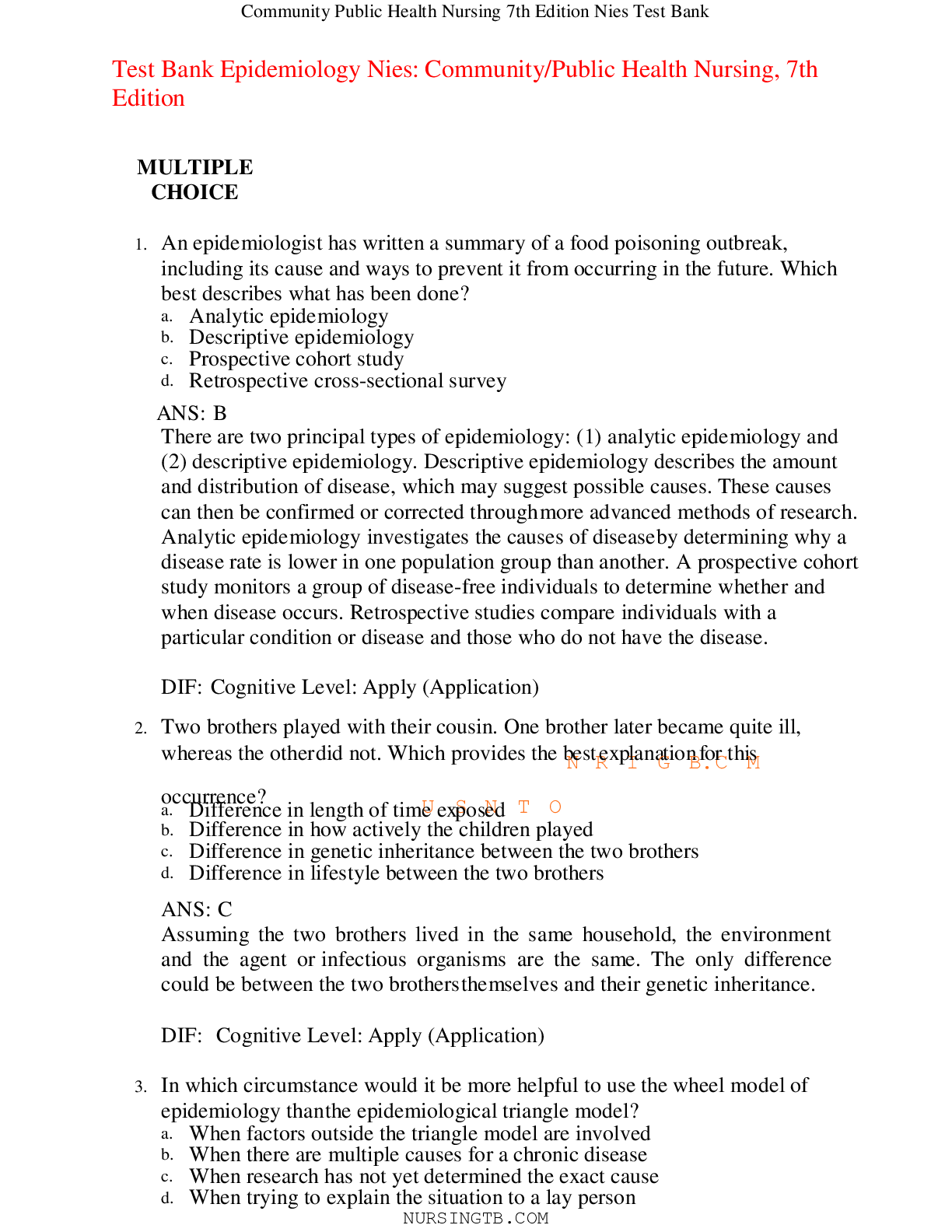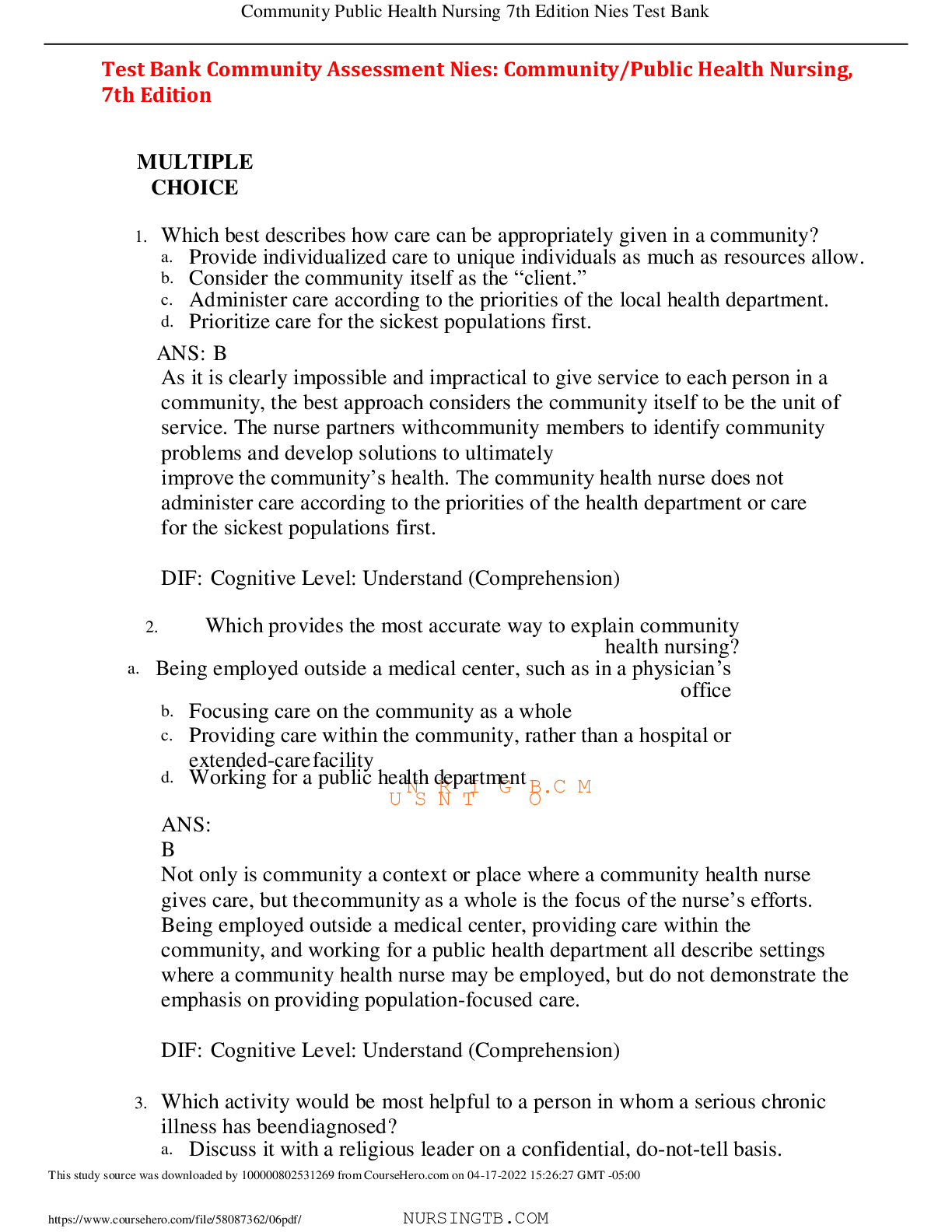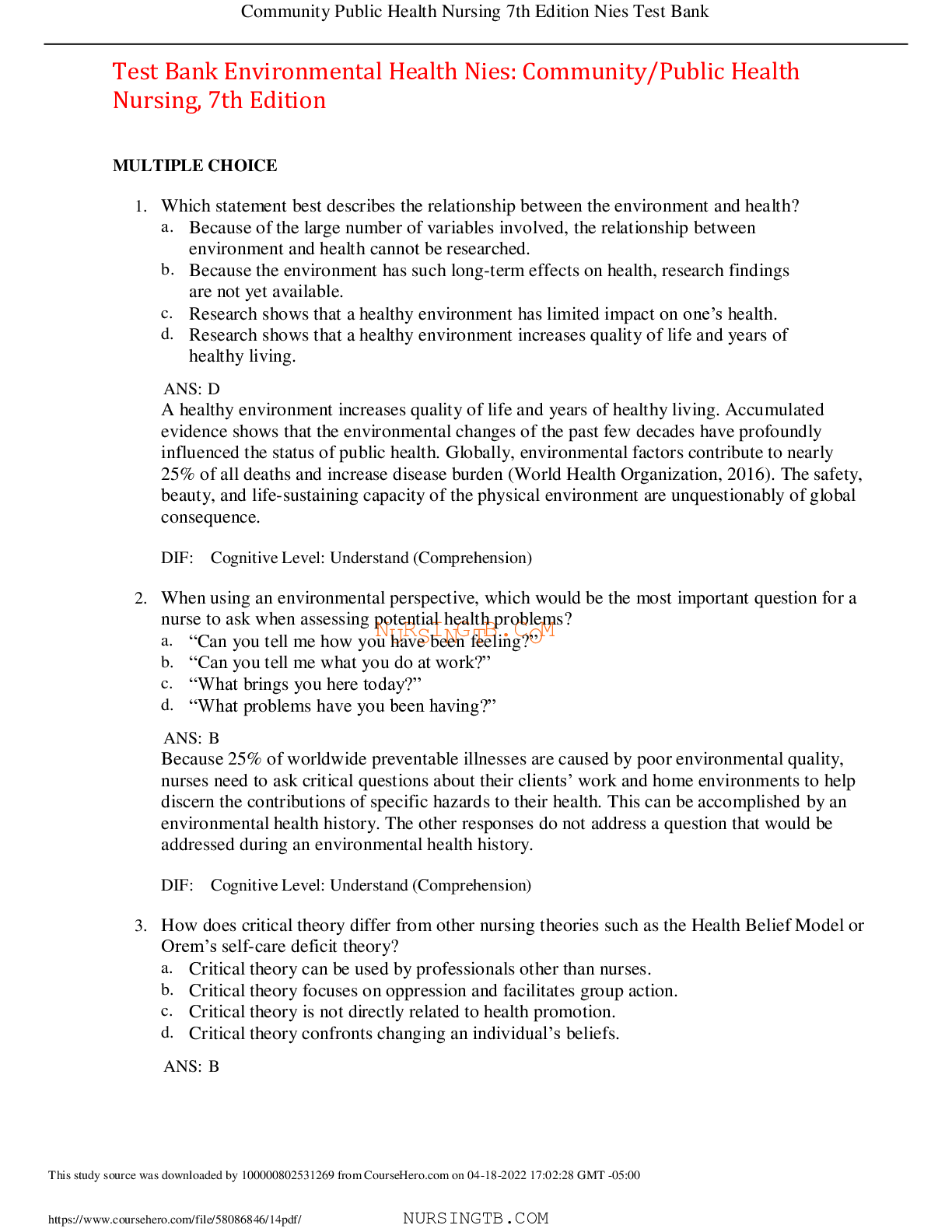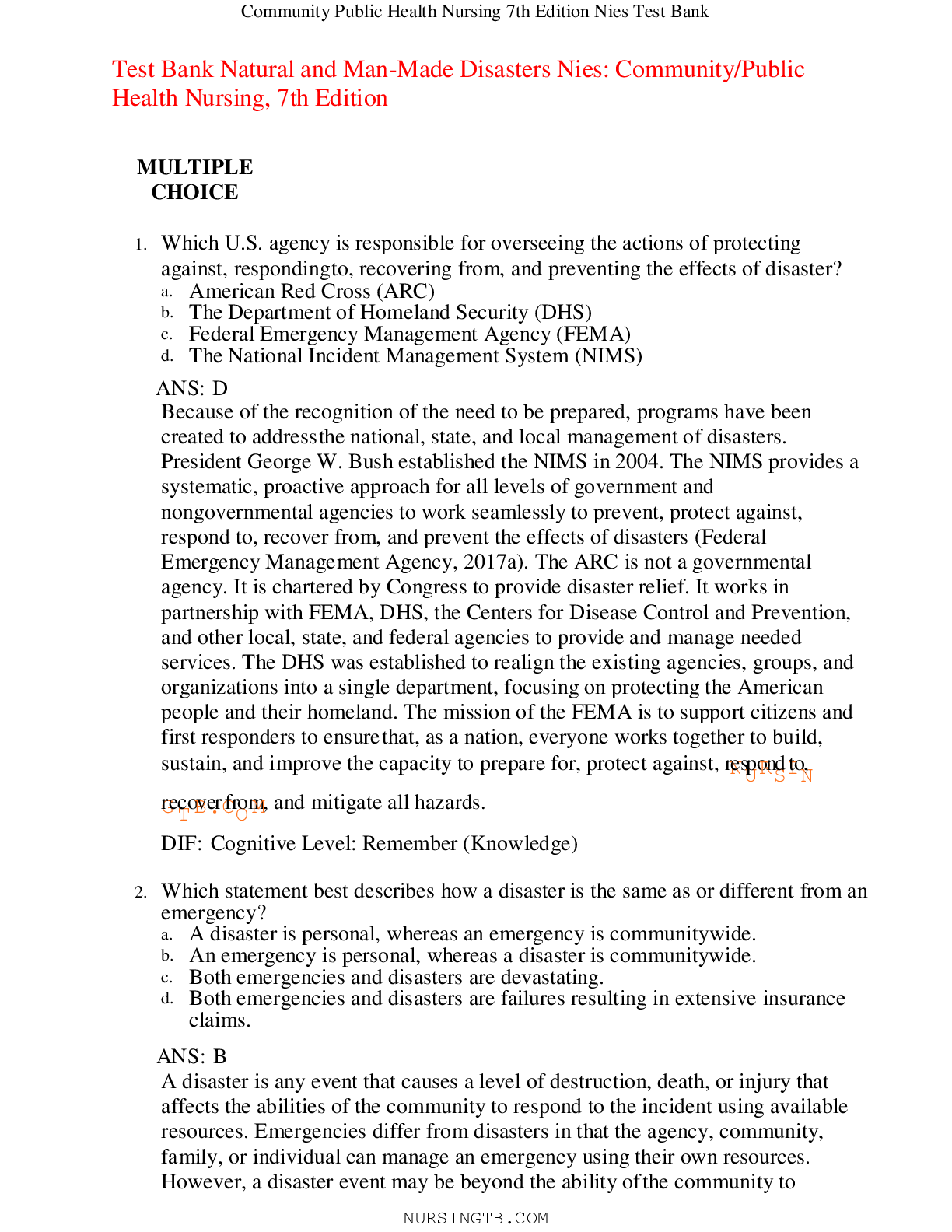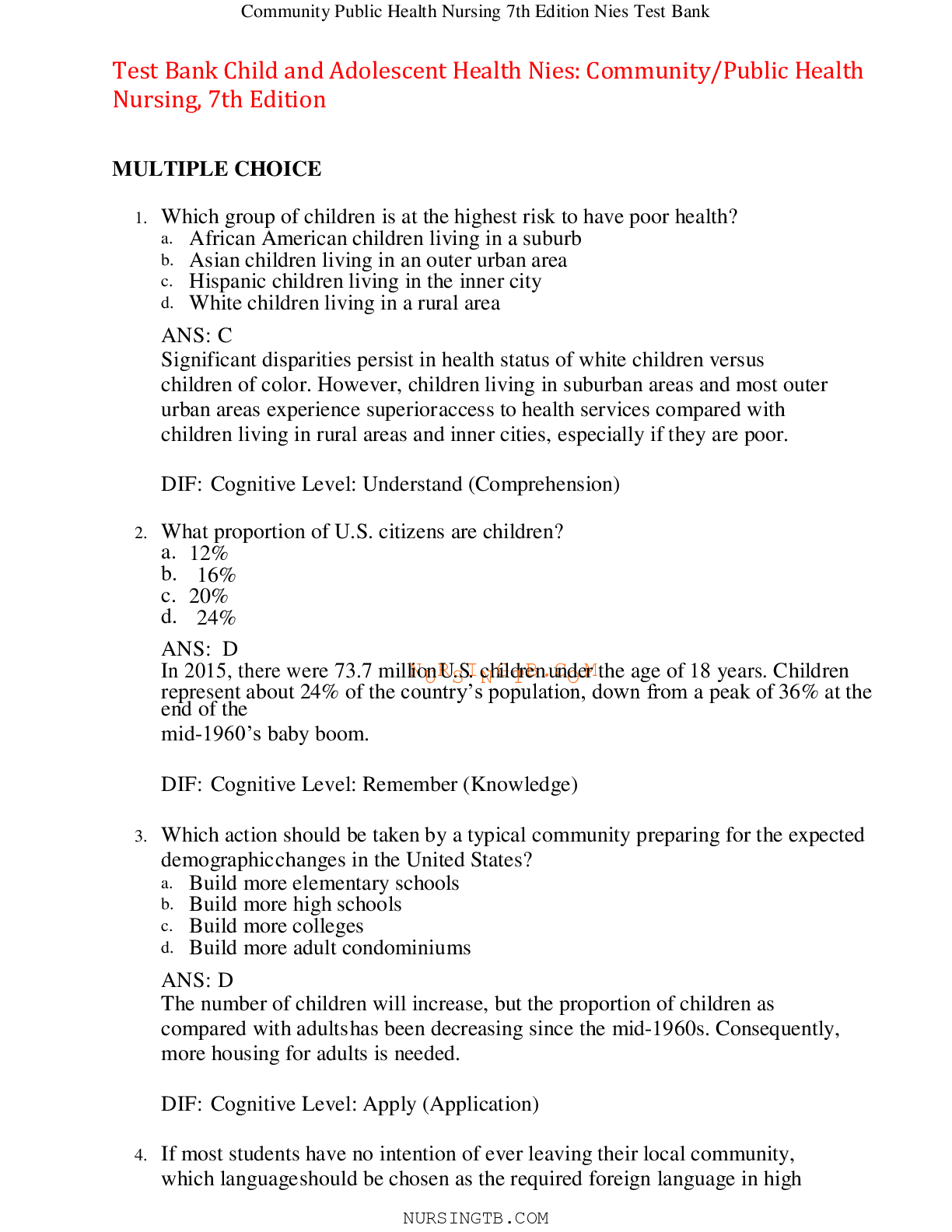*NURSING > TEST BANK > Test Bank Rural and Migrant Health Nies: Community/Public Health Nursing, 7th Edition,100% CORRECT (All)
Test Bank Rural and Migrant Health Nies: Community/Public Health Nursing, 7th Edition,100% CORRECT
Document Content and Description Below
Test Bank Rural and Migrant Health Nies: Community/Public Health Nursing, 7th Edition MULTIPLE CHOICE 1. Which best describes the recent population trend in rural America? a. The number of re... sidents in rural areas of the United States is at one of its lowest levels ever recorded. b. Urban population rates increased from 2010 to 2015 as agricultural opportunities diminished. c. Nonmetro population rates have been steadily increasing because of increasing job growth. d. Population growth or loss in rural areas varies widely depending on available economic opportunities. ANS: D Although the urban growth rate has been steadily climbing since 1890, with numbers of urban dwellers surpassing those in rural areas around 1920, the number of rural residents is the highest in the country’s history (U.S. Department of Agriculture [USDA], 2016). In 2010 to 2015 population loss in nonmetro areas occurred in the United States as a whole. In 2014 nonmetro populations stabilized after 4 years of decline, likely related to improved rural employment growth (USDA, 2016). Opportunities for population growth and economic expansion vary widely from one nonmetro county to the next, and new regional patterns of growth and decline have emerged in recent years. DIF: Cognitive Level: UndersNtandR(CoImpGreheBns.ioCn) M U S N T O 2. Which best explains why there are so few hospitals in rural areas? a. Few nurses and physicians enjoy the rural lifestyle. b. Historically, hospitals began in large urban areas and have slowly expanded outward but have not yet reached all rural areas. c. Rural areas have very low population density. d. Rural residents do not trust hospitals, preferring to receive care from neighbors and friends. ANS: C Although 75% of U.S. counties are classified as rural, they contain only 20% of the U.S. population. The population density is too low to support a large hospital. There are providers available to serve the population and residents are accepting of health care services, but not as many services are needed because of the lower population density. DIF: Cognitive Level: Remember (Knowledge) 3. From which causes are rural residents twice as likely to die from in comparison with urban residents? a. Chronic diseases, especially cardiac problems and cancers b. Diabetes from the higher incidence of obesity c. Respiratory diseases (from pesticides and herbicides) d. Unintentional injuries ANS: D Residents of rural areas are nearly twice as likely to die of unintentional injuries, including motor vehicle accidents, when compared with their urban counterparts. The rates of chronic diseases, diabetes, and respiratory diseases are more similar to that of urban residents. DIF: Cognitive Level: Remember (Knowledge) 4. Which factor would cause a geographic area to be called a frontier area? a. Arbitrary distinction recognizing the Great Plains, Intermountain areas, and Alaska b. Geographically located in the West, specifically the Great Plains states c. High death rate from use of guns (homicide or suicide) d. Population of fewer than six persons per square mile ANS: D Areas are classified as rural for populations with fewer than 45 persons per square mile and as frontier for geographic areas with fewer than six people per square mile. Many counties of the Great Plains, Intermountain West, and Alaska are designated frontier. Not all mountain areas are rural (the Appalachian mountain area is not), and geographic location alone does not make an area rural. DIF: Cognitive Level: Understand (Comprehension) 5. Which best describes the purpose of the core-based statistical areas (CBSA) system? a. To reflect trends in population distribution across the county b. To differentiate between urban and metropolitan areas c. To emphasize the importance of noncare areas d. To report the demographic characteristics of those living in the area ANS: A NURSINGTB.COM In June 2003, the Office of Management and Budget (OMB) released a new classification scheme to better reflect trends in population distribution across the nation (OMB, 2016). The MSA designation has been replaced by county-level core-based statistical areas (CBSAs) to simplify the multilevel designations. Within CBSAs, metropolitan areas are those counties that contain at least one urbanized area of 50,000 or more people. A micropolitan area contains a cluster of 10,000 to 50,000 persons. Counties that are neither metropolitan nor micropolitan are called “outside CBSAs,” also known as noncare areas (U.S. Census, 2013). DIF: Cognitive Level: Understand (Comprehension) 6. Which compositional factor influences rural health needs? a. Demographics of the people living in an area b. Local environment c. The geography of the area d. The political and social institutions in the community ANS: A There is a growing emphasis on the distinction between context, which is defined by the characteristics of places of residence, and composition, which is the collective health effects that result from a concentration of persons with certain characteristics. Problems in rural areas are compositional when they derive from individual characteristics of groups of people residing in rural settings. Examples of compositional sources of health disparities include such characteristics as age, education, income, ethnicity, and health behaviors. The environment, geography, and political and social institutions are considered to be characteristics of place. DIF: Cognitive Level: Remember (Knowledge) 7. Which describes what has been identified by public health experts as the number one priority in rural areas? a. Access to health care b. Access to education c. Access to telecommunications d. Access to better-paying employment opportunities ANS: A In the Rural Healthy People 2020 survey, 80% of respondents listed access to health care as a top rural priority. Although access to education, telecommunications, and well-paying employment are important, they have not been identified as the number one priority in rural areas. DIF: Cognitive Level: Understand (Comprehension) 8. Which would be true for a county to be defined as having persistent poverty? a. Being in poverty over theNlasRt 10IyeaGrs B.C M b. Being in poverty over the lUast 2S0 yNearsT O c. Being in poverty over the last 25 years d. Being in poverty over the last 30 years ANS: D Persistent poverty is defined as counties where the population has been in poverty over the last 30 years. DIF: Cognitive Level: Remember (Knowledge) 9. Which fact is noteworthy about adolescent males who are driving without a license in the countryside? a. Most had driver’s education classes but have not yet earned the money to pay for their driver’s license test. b. Most were Hispanic or black from a rural area. c. Most were practiced in driving large farm machinery and were just going from one section of the farm to another section. d. Most were practicing their driving skills with their parent in the car. ANS: B Researchers studied the prevalence of unlicensed teenaged drivers compared with licensed drivers and found that they were more likely black or Hispanic and live in rural areas. There is not any research in the text that supports that the other responses are accurate. DIF: Cognitive Level: Understand (Comprehension) 10. Which is particularly prevalent in rural areas (more so than in urban areas) of the South? a. Falls and motor vehicle accidents b. Less use of seatbelts and more drinking of alcohol c. Obesity and sedentary lifestyle d. Suicide and homicide ANS: C Rural residents in the southern states are more likely to be obese, smoke more heavily if they do smoke, use smokeless tobacco, and engage in sedentary lifestyles. Rates of motor vehicle accidents and suicide are higher in rural areas, although not necessarily the South. Additionally, there is a decreased use of seatbelts and increased use of alcohol in rural areas; however, the textbook mentions that these rates are higher in the rural West than in the rural South. The rates of falls and homicide are not addressed in the textbook. DIF: Cognitive Level: Remember (Knowledge) 11. Which statement best describes how firearm injuries are different in rural areas as compared with urban areas? a. In rural areas, firearm deaths occur more frequently because of purposeful, rather than accidental, shooting. b. In rural areas, firearm injuries occur more frequently in the home. c. In rural areas, firearm injuries occur more frequently during official hunting season, whereas the frequency does not vary in urban areas. d. In rural areas, firearm injuries are more frequently fatal than in urban areas. ANS: B NURSINGTB.COM In rural counties, nonfatal firearm injuries occur most often at home compared with urban counties, where injuries occur most often in the streets. DIF: Cognitive Level: Understand (Comprehension) 12. Which group is the fastest-growing component of the rural population? a. Disabled adults b. Elderly women c. Hispanic children d. Retirees ANS: C Today, the proportion of Hispanic children is the fastest-growing component of the rural population, regardless of region. DIF: Cognitive Level: Remember (Knowledge) 13. Which best explains why companies do not build work places in rural areas where people are anxious to find full-time employment? a. Employers need highly educated and skilled employees. b. Managers do not want to be transferred into a rural area where they will not fit in and will not be comfortable. c. Rural persons do not work as hard as urban dwellers. d. Smells emanating from farms are unacceptable to persons working inside. ANS: A Counties that have a low-wage economy have difficulty providing the infrastructure needed to provide education for low-wage families. They therefore have difficulty attracting new employers who might contribute to the economic development of a rural area but need a more highly educated workforce. Rural workers are known for their strong work ethic, but they may not have the educational skills that are necessary. Smells from farms is not a typical reason as to why companies do not build in rural areas. DIF: Cognitive Level: Understand (Comprehension) 14. Which employment opportunities are among the most dangerous? a. Food processing, textiles, and transportation b. Highway construction, ranching, and public utilities c. Large mechanized factory positions d. Mining, forestry, and fishing ANS: D Industries with the highest death rates were mining, agriculture, forestry, and fishing, followed by construction, transportation, and public utilities. DIF: Cognitive Level: Remember (Knowledge) 15. A public health nurse is working in a rural clinic. On the basis of risk, which would be the priority group for care? a. African American adults b. Adolescents NURSINGTB.COM c. Elderly women who live alone d. Migrant and seasonal farmworkers (MSFW) ANS: D In general, MSFW may have the poorest health of any aggregate in the United States, and the least access to affordable health care. Eighty-five percent of the MSFW are Hispanic, Latino, or African American. DIF: Cognitive Level: Apply (Application) 16. As a concerned citizen and professional, a nurse encourages the local senators and representatives to support expansion of health clinics for the poverty stricken. Which location is in most desperate need? a. Rural areas where migrant and seasonal farmworkers (MSFW) labor b. Inner city poverty-stricken neighborhoods c. Near elderly low-income housing units d. Inside high schools in poverty-stricken neighborhoods ANS: A In general, MSFW may have the poorest health of any aggregate in the United States and the least access to affordable health care. Thus, a location that serves this population would be most important. DIF: Cognitive Level: Apply (Application) 17. Which is the most frequent cause of farm fatalities and nonfatal injuries? a. Manure pits (methane poison) b. Power take-off augers c. Storage silos d. Tractors e. Very old and barely functioning trucks ANS: D Agricultural machinery is the most common cause of fatalities and nonfatal injuries of U.S. agricultural workers, including on-farm fatalities among youth under 20 years of age (CDC, NIOSH Program, 2012). Tractors contributed to 12% of the deaths. Fatalities on farms were 20.2 per 100,000 workers in 2012, with tractor overturns being the leading cause of death. DIF: Cognitive Level: Remember (Knowledge) 18. Which statement best describes how working on a farm is different from working in a factory? a. Factories have more dangerous dust than farming dust. b. Farm chemicals are more immediately fatal than most industrial chemicals. c. The worksite and the home are the same. d. Workers on farms, unlike those in factories, can bring dangerous substances home on their clothing, which expose their families. ANS: C Farming is unusual because the home and the worksite are the same. Several types of farming activities are associated with higher-than-expected occurrences of acute and chronic respiratory conditions. Individuals with long-term exposure to grain dusts, such as grain elevator workers and dairy wNorUkRerSs,IhaNvGe TdiBm.inCisOheMd respiratory function and increased frequency of respiratory symptoms. Occupational asthma and more exotic fungal or toxic gas-related conditions occur in higher frequency in agricultural than nonagricultural populations. Exposure risks to children and spouses may be heightened when farmers wear contaminated clothing and boots into the home, but the same can happen in several industries. DIF: Cognitive Level: Understand (Comprehension) 19. A woman stumbled into the rural health clinic and explained that she had an incredible headache. She was sweating and began vomiting into the wastebasket by the intake nurse’s desk. Which diagnosis should be anticipated by the nurse? a. Acute adult panic disorder b. Acute alcohol intoxication c. Acute appendicitis d. Acute meningitis e. Acute pesticide poisoning ANS: E Signs and symptoms of acute pesticide poisoning are fairly clear, and most health providers in rural communities would recognize them. Common symptoms include headache, dizziness, diaphoresis, nausea, and vomiting. If left untreated, those affected may experience a progression of symptoms including dyspnea, bronchospasm, and muscle twitching. Deaths are relatively uncommon, but they do occur. The nurse is reminded that not all farm laborers are men. The symptoms that are being displayed are not typical of acute panic disorder, acute alcohol intoxication, acute appendicitis, or acute meningitis. DIF: Cognitive Level: Apply (Application) 20. A nurse is explaining why migrant farmworkers experience cultural barriers when trying to receive care. Which would the nurse include in this explanation? a. “As illegal immigrants, they are not eligible for tax-paid health care.” b. “Families who travel in isolation seeking agricultural work do not mix with their employers or other members of the community.” c. “Mexicans who speak primarily Spanish and cannot understand English.” d. “Usually perceived as outsiders, they are from many countries and cultures.” ANS: D Cultural, linguistic, economic, and mobility barriers all contribute to the nature and magnitude of health problems observed in farmworkers. Cultural and linguistic barriers are the most overt because many of the communities where farmworkers work consider them outsiders. A common misconception among U.S. health care providers is that these farmworkers are from Mexico, with Spanish as their primary language. Farmworkers originate from many communities in Mexico, the Caribbean, and Central and South America, and they may speak English, the language of their home country, or several languages. DIF: Cognitive Level: Apply N(AUpRplSicaItiNonG) TB.COM 21. A nurse was becoming very frustrated at the ongoing stream of farmworkers with respiratory problems each spring. Which action should be taken by the nurse? a. Provide community education on herbicides and other chemicals spread each spring with information on self-protective measures, such as respirators. b. Fight to get farmers to quit spreading chemicals on their fields each spring. c. Suggest that farmers spray water on the fields immediately after the chemicals are spread to reduce dust in the air. d. Tell farm workers to obtain different employment. e. Try to get farmers to reduce the amount of chemicals used on their fields. ANS: A Environmental health issues in rural communities, such as pesticide exposure or health hazards from point-source factory emissions, are more effectively assessed and remedied on a community level than on a case-by-case basis. Nurses’ involvement in helping people understands health problems in a larger context can be the genesis of change. It is not realistic to have farmers quit or reduce the spreading of chemicals, spray water on their fields after chemical application, or ask them to obtain different employment. Nurses must work with farmers so that they are able to use safe measures when applying the chemicals to their fields. DIF: Cognitive Level: Apply (Application) 22. A nurse was trying to decrease the amount of respiratory illness in the community. Which approach should be used by the nurse? a. Attend each farmworkers’ meeting and listen to how they perceive and discuss their problems b. Offer to teach the farmers’ spouses how to protect their families, such as having the farmer shower and change clothes before coming into the house c. Suggest the community work together to obtain a community college so farmworkers could be educated for other employment opportunities d. Teach children in the school system the importance of seeking employment in cities rather than staying on the farm ANS: A Using informal networks in the community is essential. The involvement of informal networks and local leaders in planning health interventions is crucial. To be able to do that, the nurse must first listen to how the community perceives its problems. DIF: Cognitive Level: Apply (Application) 23. Which best describes a proposed strategy to address the lack of health care professionals in rural communities? a. Advertise that there are more men than women in many rural areas to attract female nurses who want to be wives and mothers b. Offer free housing and office space to a professional who will come to live in the community c. Pay extremely high salaries to professionals willing to relocate d. Support local students obtaining an education while continuing to live at home ANS: D NURSINGTB.COM A solution proposed for the shortage of health care providers is for rural communities to “grow their own.” A rural community, a group of small communities, or a county could support local students attending college and recruit students currently attending professional schools. The students make a commitment to work in the community in return for monetary support for their educations. DIF: Cognitive Level: Understand (Comprehension) 24. Which difference is found in parish nursing in a rural area as opposed to parish nursing in an urban area? a. Rural parish nurses are less likely to be involved in case management or care coordination than their urban counterparts. b. Rural residents are more grateful for the nurse’s assistance because there are so few health resources in rural areas. c. Rural residents are typically less committed to traditional values or a strong religious faith. d. Rural residents may discuss health concerns with the nurse wherever they meet, whether in church or the local market. ANS: D In urban settings, contact with parishioners was primarily at the church, whereas contacts in rural settings were most often in the home, on the phone, or in other community-based settings. DIF: Cognitive Level: Understand (Comprehension) 25. A nurse saw there was a need for a hospice facility in a rural area, because so many of the residents were quite elderly and death was common. Which best explains why the community would not immediately see the wisdom of the nurse’s suggestion? a. Change is always difficult; the nurse just needs to keep reinforcing the need for such a facility. b. The nurse did not tell residents how much their taxes would need to go up to support such a facility. c. Residents were fearful of confronting death in such an open way. d. Rural residents prefer to use their informal social support networks when help is needed. ANS: D Limited availability and accessibility of formal health care resources in rural areas combined with self-reliance and self-help traits of rural residents have resulted in the development of strong rural community informal care and social support networks. Rural residents are more apt to entrust care to established informal networks than to new formal care systems. It is unlikely that creation of such a facility would impact their taxes. The nurse needs to partner with the community to implement the change process while building upon the community’s strengths, beliefs, and values systems. DIF: Cognitive Level: Understand (Comprehension) 26. Which would most likely to be provided by a local health department in a rural community? a. Collaborating with local NhealRth cIlinicGs toBp.roCvidMe outreach services b. Funding a local research prUojecSt N T O c. Establishing the poverty guidelines for the area d. Building a free-standing migrant health clinic ANS: A Uniquely positioned within rural communities, LHDs are a potential catalyst for addressing the long-standing challenges associated with urban–rural health disparities. While focused on improving the health of populations, LHDs provide a wide array of services focused on assessing health status, mobilizing action to address health-related issues, and ensuring the delivery of important health services in the community. The ability of rural health departments to develop and cultivate partnerships is important for the integration of public health within the larger health care delivery system. The local health department would be more likely to collaborate with existing resources before building its own free-standing clinic. Poverty guidelines are established by the federal government. It is unlikely that a local health department in a rural area has funding available for research projects. DIF: Cognitive Level: Understand (Comprehension) 27. Which best describes how the federal government tries to both encourage and support rural health clinics under the Community Health Centers (CHC) program? a. Allowing tax deductions for charitable contributions to rural health clinics (RHCs) b. Donating equipment and supplies to establish such clinics c. Reimbursing both Medicare and Medicaid at a higher rate than otherwise d. Requiring recipients to serve in a rural health clinic for 3 years in exchange for financial assistance while in school ANS: C The CHC program, administered by the U.S. Public Health Service, benefits underserved areas and populations. RHCs are designed to improve access to primary care. As an incentive to rural communities to apply for RHCs, Medicare and Medicaid are reimbursed at a higher rate than usual. DIF: Cognitive Level: Understand (Comprehension) 28. Which best describes how Migrant Health Clinics (MHCs) under the Migrant Health Program are often different from other clinics? a. Care is restricted to those who can document that they are employed in agriculture. b. They are much better funded than typical rural clinics. c. Staff are typically bilingual and bicultural. d. They welcome illegal immigrants to receive care. ANS: C The MHCs and the Migrant Health Program provide comprehensive nursing and medical care and support services to migrant and seasonal farm workers and their families from many countries in Latin America and the Caribbean. Bilingual, bicultural health personnel, including lay outreach workers, use culturally appropriate protocols for providing primary care, preventive health care, transportation, dental care, pharmaceuticals, and environmental health. The funding at the MHC may not be any different than other rural clinics. Their primary purpose is not to provide care to illegal immigrants, rather to migrant and seasonal workers. DIF: Cognitive Level: UndersNtaUndR(SCoImNpGreTheBns.ioCn)OM MULTIPLE RESPONSE 1. Which factors result in rural residents having less access to health care than urban dwellers? (Select all that apply.) a. Employment opportunities may be low paying and seasonal. b. There are greater distances to travel and limited choice of health care providers. c. Health care providers prefer to work in higher-paying urban settings. d. Rural residents are less likely to have health insurance. e. Rural persons’ economic resources are tied up in land, not easily accessible cash. f. Rural persons believe in self-sufficiency and self-care, not asking others for help. ANS: A, B, C, D A recent Institute of Medicine study reported rural medical access problems in these areas, with some hospital and pharmacy closures; greater distances to travel for physician services; and limited, if any, choice of providers. Rural residents were more likely than urban residents to lack insurance. In 2015, about 18% of the persons living in rural counties were at the poverty level. Having economic resources invested in land and believing in self-sufficiency and self-care are not reasons why rural residents have less access to health care than urban dwellers. DIF: Cognitive Level: Remember (Knowledge) 2. In comparison with mental health care in urban areas, which best describes how mental health care in rural areas differs? (Select all that apply.) a. Access to care is more limited or not available at all locally. b. Cost for treatment is typically reimbursed at a lower rate. c. Depression is frequently not recognized or is not treated. d. Ethnic and racial disparities exist. e. Primary health care professionals accept responsibility for mental health treatment. f. The suicide rate is notably higher. ANS: A, C, E, F Nationally, suicide is the 11th leading cause of death, but in rural America it is the second leading cause of death. Decreased access to mental health services for treatment of depression may contribute to these higher rates. Because of the lack of qualified mental health care providers, rural residents often receive services from primary care providers. Ethnic and racial disparities exist whether in urban or rural health care. DIF: Cognitive Level: Understand (Comprehension) 3. Which best describes why for-profit managed care organizations (MCOs) have not begun to move into rural areas to increase the number of persons served? (Select all that apply.) a. High startup and administrative costs are needed. b. A large number of elderly are on Medicare or Medicaid, which results in low reimbursement. c. Managed care has not yet had time to go beyond major population centers. d. MCOs are waiting until federal reimbursements for underserved rural health areas become higher. e. The population is too small and too spread out. f. Rural health areas are too gUeogSraphNicaTlly unatOtractive and lack any recreational possibilities for managers to want to work there. ANS: A, B, C, E MCOs recognize the risks to expanding into rural areas. Risks are probable high startup and administrative costs. Managed care has yet to move into much of rural America because of small dispersed populations, few visits per individual, and large numbers of elderly on Medicare with low-level reimbursements that do not make the aggregate financially attractive to MCOs. It is not likely that federal reimbursements for underserved rural health areas will become higher. The lack of attractive living for managers has not been a reason why MCOs have not moved into rural areas. DIF: Cognitive Level: Understand (Comprehension) 4. A nurse has written a research proposal studying how technology can be used in innovative ways in rural areas to improve patient outcomes. Which should the nurse contact about funding opportunities? (Select all that apply.) a. Research Centers Program b. Health and Human Services Department (HHS) c. Health Resources and Services Administration (HRSA) d. Federal Office of Rural Health Policy e. Rural Health Research Gateway f. The Center for Rural Health at a local university ANS: A, D, F The HRSA provides access to and support for research through the Research Centers Program. The Research Centers Program is the only federal research program entirely dedicated to producing policy-relevant research on health care and population health in rural areas. Each research center has its own identity (although it may be part of a larger organization), website, and core staff that include a disciplinary mix of health services research, epidemiology, public health, geography, medicine, and mental health. Over the 4-year award cycle, each research center develops a portfolio of several research projects per year in conjunction with input from the Federal Office of Rural Health Policy and other experts. Universities across the country have created centers for rural health research. To strengthen the dissemination of research results, the Rural Health Research Gateway is a “one-stop shop” for the research centers, providing easy access to projects funded by ORHP and summaries of research in progress. The Health and Human Services Department does not provide funding for rural area research. DIF: Cognitive Level: Apply (Application) 5. Which best describes why there are more long-term consequences (such as death) to a driver injured in a truck accident in a rural area than a driver injured in a truck accident in an urban area? (Select all that apply.) a. Rural drivers are more likely to speed over long distances than urban drivers. b. Rural drivers are not as skilled with vehicles as urban drivers, so they are more severely injured in a crash. c. The urban driver is taken immediately for care, whereas the rural driver might be injured on an isolated field and not found by anyone for hours. d. Urban drivers are more likely to use their seat belts than rural drivers. e. Urban drivers are probabNlyUruRsSheIdNtoGaTnBem.eCrgOeMncy department, whereas the rural driver lives far away from emergency services, often over bad roads and possibly through severe weather. f. Urban drivers trade their vehicles in rather frequently, whereas rural drivers keep their vehicles for as long as they can make them run, so the vehicles are much less roadworthy. ANS: A, C, D, E Getting patients from the place of injury to the trauma center within the “golden hour” is frequently not possible in rural areas because distance, terrain, climatic conditions, and communication methods produce barriers. Some rural facilities are more than 1 hour away by air from the nearest trauma center or tertiary care hospital. Driving at high speeds, driving long distances, driving in winter conditions, not using seat belts, and consuming alcohol have been cited as contributing to greater levels of injury deaths and disability by rural residents in the West. There is no evidence to suggest that rural drivers are not as skilled as urban drivers or that their vehicles are less roadworthy. DIF: Cognitive Level: Understand (Comprehension) 6. Which do expert rural nurses report as benefits of their work? (Select all that apply.) a. Ability to develop close relationships and give holistic care b. Being able to practice in the community where one lives c. Constant challenges d. Continual growth as an expert generalist e. Higher salary than in urban areas f. Intensity of purpose ANS: A, B, C, D, F Positive aspects of rural nursing include the ability to give holistic care, to know everyone well, and to develop close relationships with the community and with coworkers. Autonomy, professional status, and being valued by the agency and community have been reported components of positive job satisfaction. The rural nurse is a generalist, and generalist is not synonymous with boring. Interviews with rural nurses show that they feel an “intensity of purpose” that makes rural nursing distinctive. Nurses living and practicing in the same place have a strong sense of integration and continuity between practice and community. DIF: Cognitive Level: Understand (Comprehension) NURSINGTB.COM [Show More]
Last updated: 1 year ago
Preview 1 out of 25 pages
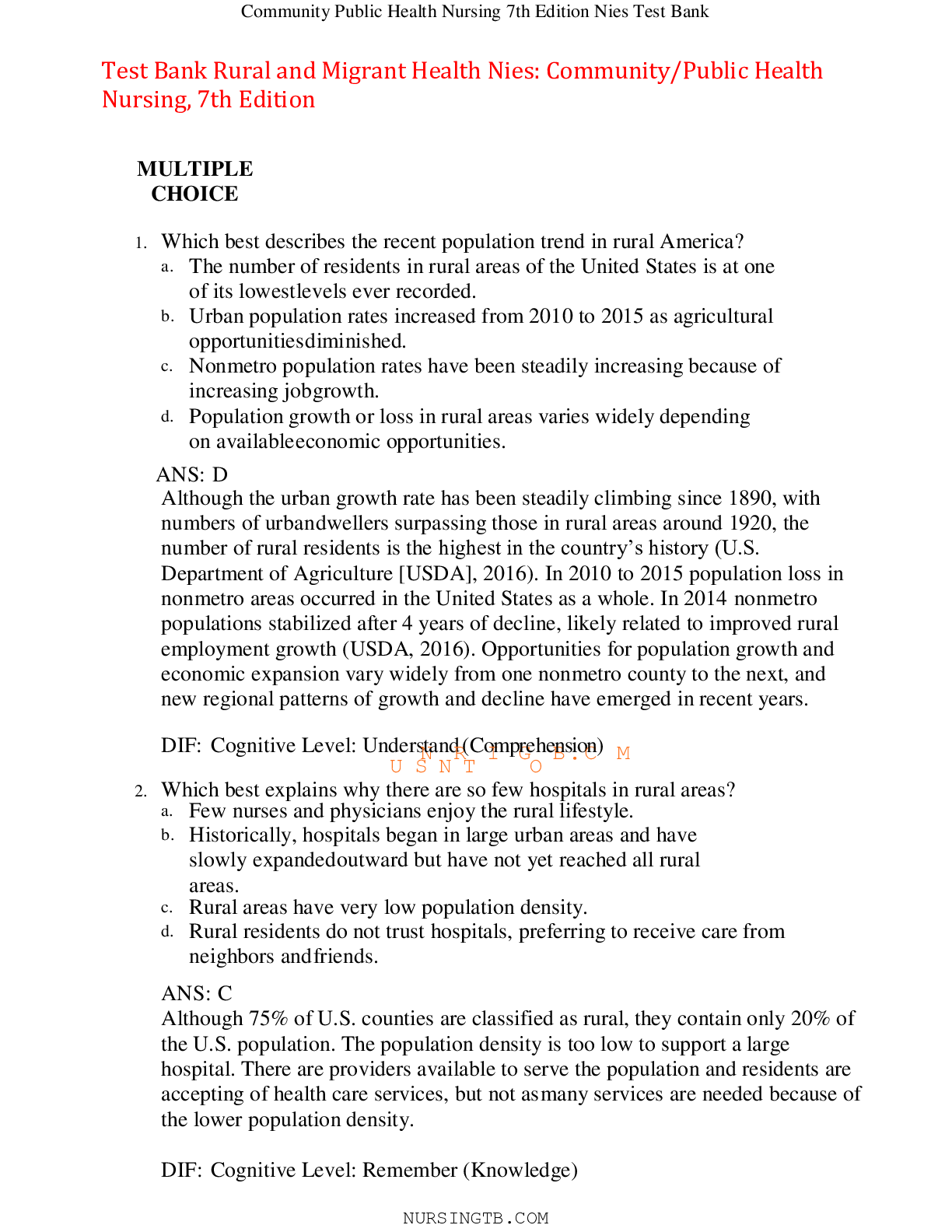
Reviews( 0 )
Document information
Connected school, study & course
About the document
Uploaded On
May 03, 2022
Number of pages
25
Written in
Additional information
This document has been written for:
Uploaded
May 03, 2022
Downloads
0
Views
38




